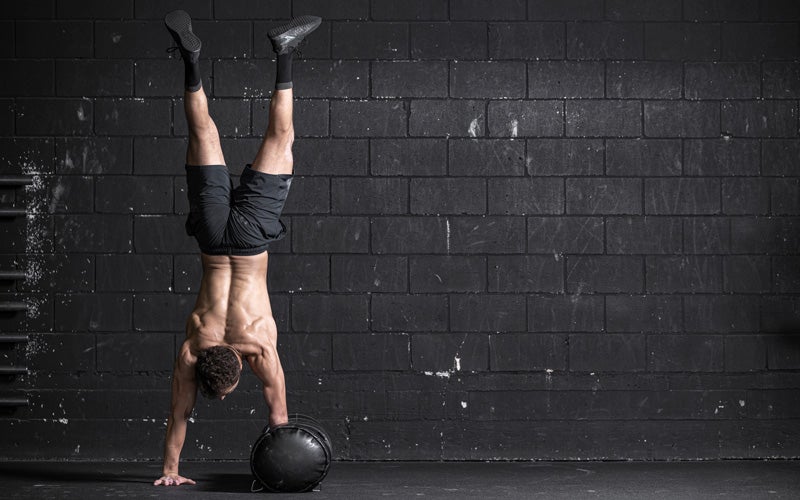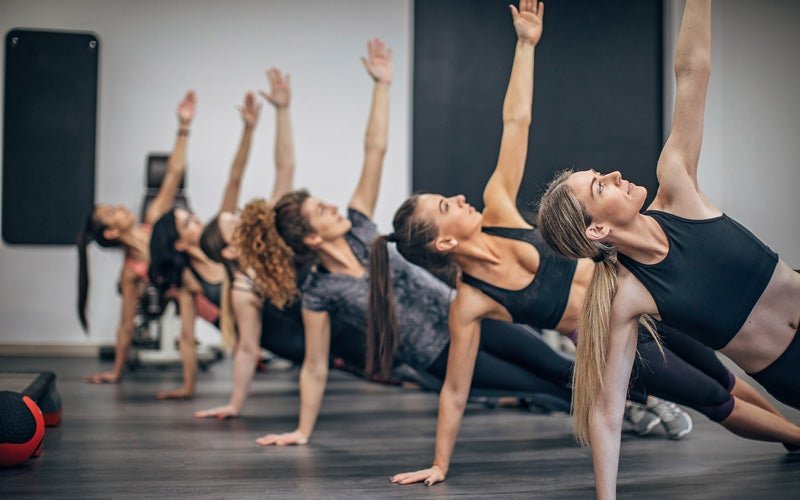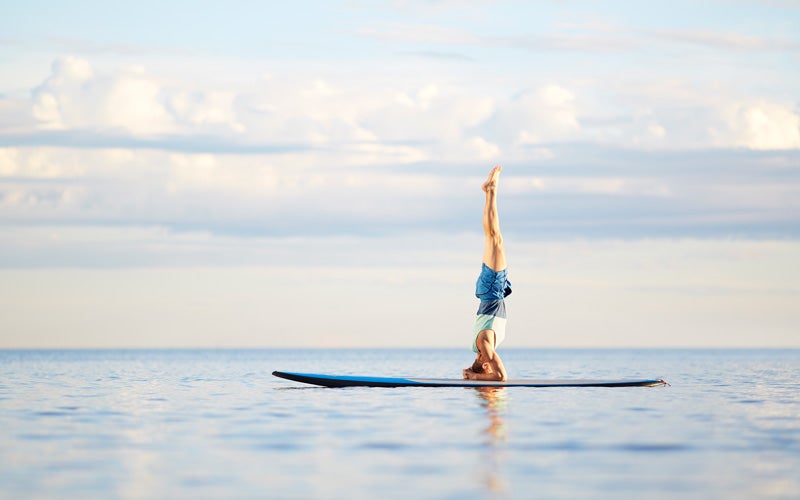7 Stabilization Exercises You Should Know
 ©Westend61
©Westend61
Stabilization exercises improve your muscle tone and your balance. Athletes who want to improve their performance should incorporate stability exercises into their routine. Here are the best tips and exercises for improving your balance you can start off with right now!
What are stabilization exercises?
Stabilization exercises, or stability exercises, are exercises that challenge and increase your body’s stability. The more developed your stability is, the better you can maintain your balance and compensate for imbalances – for example, when standing on an uneven surface or on only one leg.
Stabilization exercises are usually isometric strength exercises — meaning you’re not moving while performing them or moving only a little. Instead, you stay in a static position, such as a standing balance, for most of the exercise. As you can imagine, stabilization training requires a high degree of control, muscle tone, and concentration.

What do stability exercises train?
Stability exercises focus on training your midsection (your core). A lot of muscles hold your core together. These trunk muscles include:
- Abdominal muscles (abs)
- back extensors and deep back muscles
- Shoulder muscles
- gluteal muscles (glutes)
- posterior thigh muscles
- hip muscles
These muscles, which are specifically trained with stabilization exercises, are responsible for straightening the spine and bending or rotating the upper body.
Stabilization exercises also help relieve pressure on the vertebrae, and can help prevent back problems. Runners who included stability training in their regular routine can better cushion their strides and thus protect their spine, tendons, and joints.
In addition, stability exercises can improve your posture and transfer power from your core to your arms and legs more efficiently, which will improve your performance no matter your favorite sport.
Who is stabilization training useful for?
Maybe your knee hurts while you’re jogging, or your shoulder can’t support you after your first set of pull-ups, or you leave your shadowboxing classes with a bad back. Is any of this familiar?
Many athletes accumulate their aches and pains over the years. The cause of their ailments is often one-sided, unbalanced training. Many athletes neglect stability exercises in particular because they seem to cost valuable time that they’d rather spend elsewhere.

But it’s precisely with balance training that you can increase your performance and demonstrably prevent injuries(1). Strengthening your deep core muscles allows you to perform movements more efficiently and smoothly. This benefits runners as well as cyclists, swimmers, and strength athletes.
Even non-athletes benefit from stability exercises: they promote neuromuscular coordination, i.e. the cooperation between brain and muscles. This allows you to improve your fine motor and coordination skills.
If you start early, stabilization training will help you to control your movements better into old age, giving you more confidence and independence.
Advantages of stability training
There are many good reasons for you to incorporate stability training into your routine, including:
- Stabilizing and protecting joints and tendons
- Increasing performance
- Preventing back pain or injury
- Improving posture
- Strengthening deep muscles
- Improving body awareness
- Improving fine motor skills and coordination
- Increasing concentration

Stabilization training can leverage your ability to perform better. The foundation for your progress, however, is a balanced diet. Your body needs energy from carbs, fats, and protein to build muscle. Our shakes are here to help: easy to prep and filled to the brim with good nutrients to support your strength and stability.
Stability training: frequency and duration
How often and intensively you integrate stability exercises into your fitness routine depends on your goals:
If you supplement your regular activities — like triathlon training, soccer, or weight training — with stability exercises, one or two sessions per week will do the trick. After all, you’re training an additional few hours a week and should allow yourself enough recovery time.
For example, you can incorporate two stabilization exercises for the legs and two for the upper body into your workout before a moderate run or as part of your strength training.
Do you want to do stabilization exercises as a preventive measure and to strengthen your balance and improve your posture? Then consider adding two to three 15- to 30-minute balance and stability workouts per week. Start slowly and steadily increase the intensity and duration.
For example, try to hold each exercise for a longer period of time. But always pay attention to a clean execution. Correct technique and form always come first.
7 balance and stability exercises for athletes
Plank
Start lying on your stomach: Keep your hands close to your chest beneath your shoulders, with your fingertips pointing forward. Push off the floor to a high push-up position. Think of your neck as an extension of the spine, and keep your body in one straight line, especially focused on your shoulders, torso, and glutes being even. Keep your gaze down and focus on a point between your hands. Important: Tighten your glutes, pull in your belly button, push through your knees, and flex your heels away from you.
Side Plank
Start lying on your side: Keep your elbow beneath your shoulder and your forearm resting parallel to the end of the mat. Straighten your legs, keeping them on top of each other and in line with your glutes and torso. Press the bottom outer edge of your feet and your forearm into the floor and push your hips up toward the ceiling. No sagging! Consciously activate your lateral abdominal muscles to keep yourself extended. Then switch sides.
Single Arm Plank
In the single arm plank you start as you would a regular plank. With your hands beneath your shoulders, lift your upper and lower body into the air so that your body forms a line and hold this plank position until you feel confident. Now raise one arm without losing your balance. The higher you hold it, the more you activate those stabilizing core muscles. For more intensity you can lift the opposite leg at the same time.
You can find more plank variations in our overview article on planking.
Single Leg Glute Bridge
Start lying on your back with your feet on the floor just far away so that you can touch one heel with your middle finger. Now extend one leg into the air. Next, push off the ground with the other foot and lift your pelvis. Make sure your hips stay square and don’t dip to one side. Hold at the highest point, paying attention to your core muscles and glutes. Switch legs.
Standing Glute Bridge
Start by standing upright and engaging your abs. Tilt forward with a straight back and lift one leg behind you at the same time, keeping it as straight as possible. Keep going until your upper body and leg are level with the floor. Hold the arms at the waist or stretch them out to the side or forward. Keep your pelvis straight and pointed to the floor like a spotlight. Hold this. Repeat with your other leg.
More variations of the Glute Bridge here
Pistols
Start by standing, and place your lower right leg above your left knee. Slowly come into a squat position. You can extend your arms upward or cross your hands in front of your chest. Keep your upper body straight. Stop at the lowest point and slowly straighten up again without any wobbling. This requires some serious engagement of your core. Then switch sides.
Swimmer
Lie on your mat on your stomach and extend your arms and legs. Raise your right arm and left leg as far up as possible. Relax your neck and keep it in line with your spine. Hold at the highest point for a few seconds and then lower your arm and leg back down. Repeat on the other side. For more intensity, you can raise both arms and legs in parallel.
Summary
- Stabilization exercises are designed to challenge and improve your stability.
- Stabilization exercises are usually static strength exercises in which you perform movements very slowly and hold positions as long as possible without tipping over.
- Stability training targets your core strength, improves your balance, increases your performance, and can prevent injuries or everyday or age-related back problems.
- Stabilization exercises are ideal as a supplement to a workout or as a standalone session to increase overall fitness, fine motor skills, and strength.
Sources for this article
We at foodspring use only high-quality sources, including peer-reviewed studies, to support the facts within our articles. Read our editorial policy to learn more about how we fact-check and keep our content accurate, reliable, and trustworthy.
- (1) https://pubmed.ncbi.nlm.nih.gov/17503879

































